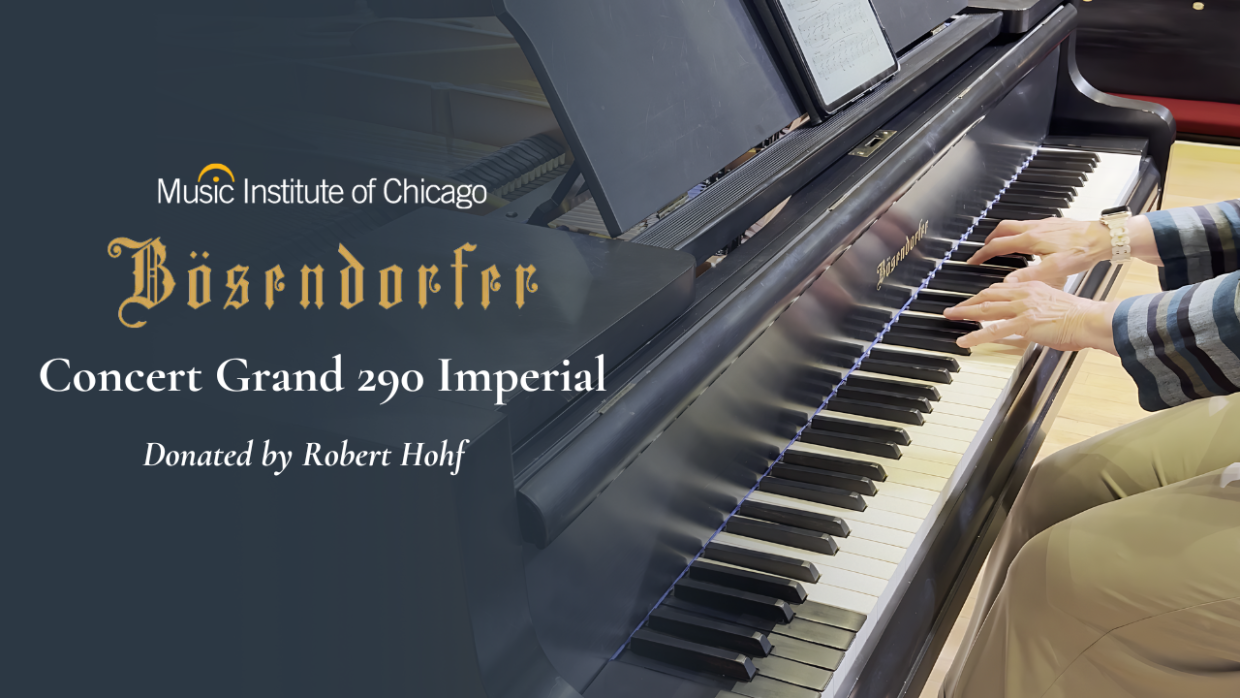Bösendorfer Imperial Grand Piano Arrives at the Music Institute of Chicago
A Historical Gem

October 14th, 2024
We’re excited to share that a truly remarkable instrument, the Bösendorfer Imperial Grand Piano, has arrived at Nichols Concert Hall, thanks to a generous donation from Robert Hohf. A highly respected technician, Hohf has previously been involved in our adult piano camp, sharing his expertise in piano craftsmanship through engaging lectures. This historical piano, known for its extended low register and impressive presence, has been a part of Chicago’s music scene, from Roosevelt University to Northwestern University, before finding its new home with us at the Music Institute of Chicago.
Now available for use by faculty, students, and renters of Nichols Concert Hall, this Bösendorfer is ready to inspire musicians of all levels.
Learn more about rental opportunities at Nichols Concert Hall
Our new video explores the piano’s fascinating story, featuring insights from Piano Department Chair Elaine Felder and piano technician Bill Schwartz. They dive into the piano's unique features and demonstrate its incredible sound.
Watch the full video to hear what makes this Bösendorfer a true musical gem!
Transcription:
Elaine Felder
Hi, I'm Elaine Felder. I'm on the piano faculty at the Music Institute and am also the department chair. This piano, this Bösendorfer, was built in 1955 by the Bösendorfer company. It started out at Roosevelt University, which was then the home of the Chicago Musical College. The president of the college at that time was a gentleman named Rudolph Ganz.
He had the piano delivered from Austria to Roosevelt. It remained there for a while, and then it went to Northwestern University. Robert Hohf bought it from Northwestern, took it to his home in Wisconsin, and rebuilt it twice. Mr. Hohf decided he would like to donate both this piano and a nine-foot-six-inch Mason and Hamlin to the school.
Bill Schwartz
Hello, I'm Bill Schwartz. I'm the piano technician for Nichols Concert Hall here at the Music Institute, and I take care of the two Steinway Ds. Now, I also have the privilege of maintaining the newly acquired Bösendorfer Imperial Grand.
One of the things people notice immediately about the Bösendorfer Imperial Grand is that it’s larger than almost any other piano. There are a couple of pianos in the world that are longer, but when we talk about size, we’re typically referring to the length of a piano. For instance, a concert grand is usually about nine feet long. A Steinway D, which is kind of a standard concert grand, is just slightly under nine feet. This Bösendorfer is nine feet six inches long. It's also wider. The far end of a piano from where the player sits is called the tail, and the tail on this piano is much wider than on a typical piano. There are a few reasons for this, one being that it has more keys—hence, more strings and more notes.
The theory behind this is not only to provide extra notes, although they do sound, and some pieces incorporate them. But one benefit, according to Bösendorfer, is that this design creates a larger soundboard and positions the strings and bridge more centrally within it. This allows for a larger, fuller, and louder resonance, especially for the lower notes. You can really hear a fullness and power in the low end. These extra keys are subtly marked with ebony instead of ivory, and while most pianos stop at the lower end, this one goes all the way down to a low C, giving it a full eight octaves.
Another feature of the Bösendorfer—and this is true for some other European pianos—is that each string is its own, separate string. In most American pianos, including Steinways and many others, you have a string that loops around a pin, forming two strings from one. So, if you break one, you’re actually breaking two strings in a unison, which affects the sound significantly. Here, each string has its own little coil and hitch pin, which helps preserve the sound quality even if one string breaks.
Elaine Felder
The fact that we now have three pianos to choose from in this hall makes it very attractive for our faculty and for people who would like to rent the hall. Now, they can choose between two nine-foot Steinways—one from Hamburg and one from New York—and this beautiful Bösendorfer, which has a completely different sound. It’s lighter and a bit brighter than the Steinway. It’s especially beautiful for playing the music of Schubert, Mozart, and early Beethoven because of its singing quality and lightness. It really suits the music of these composers very well.
Bill Schwartz
Bob Hohf completely redid the piano, including refinishing and restringing. I'm not sure if he replaced the soundboard or simply repaired it, but he definitely put in new strings and new action parts where needed, as well as new hammers. He achieved a fantastic result.
After downsizing, Bob decided to donate this wonderful piano to the Music Institute—a place that would appreciate and make good use of it. I know it was important to him that it be well-used and valued, and here, it will certainly be appreciated more than if it were just sitting in someone’s living room.
